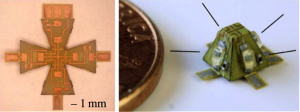High resolution lenses for machine vision — standard and custom lens design
Flying Robots
High Resolution Lenses for machine vision, instrumentation, inspection and vibration-sensitive applications. Standard and custom hi-res lens assemblies.
Researchers have built a small robot about the size of a honeybee that can fly using feedback from an onboard sensor. It’s a huge step in the development of small autonomous flying robots, and fittingly enough, the onboard sensor was inspired by the light sensors of flying insects.
Sawyer Fuller, a robotics engineer at Harvard University stated, “We had this crazy idea to make an autonomous robotic fly. One of the challenges is that as flying robots get smaller, they become more susceptible to small changes in air flow. As a result, to fly stably, they need constant feedback to perform corrective maneuvers. It’s like a tiny fighter jet,” said Fuller. “Fighter jets need to constantly make corrections or they’ll fall out of the sky, and it’s the same thing with these vehicles,” he said.

Flying Robots
The ocelli design consists of four phototransistors soldered to a custom-built circuit board that is folded into a pyramid shape. Image: Journal of the Royal Society Interface
This type of flying robot was developed a few years ago but basically relied on external cameras to track its position. With the new onboard sensor, the robot can sense its location and make the corrections needed to stay aloft by flapping two wafer-thin wings 120 times a second.
Robots rely on many parts including custom designed lenses to properly operate. Universe Optics supplies custom lenses for robotics and other applications. We carry over 1600 lenses in stock with a team of engineers who can design custom lens solutions for your particular needs.
With a vehicle that small, many onboard sensors that work on larger flying vehicles, such as gyroscopes, accelerometers, GPS, or laser rangefinders, are either too heavy, consume too much power, or don’t work well indoors. Instead, the researchers decided to try following the same approach as insects.
“To monitor and stabilize their flight orientation, flying insects use a simple strategy based on vision,” Srinivasan said.
“In addition to their compound eyes, most flying insects also possess three rudimentary light sensors called ‘ocelli,'” he said. “By monitoring and analyzing the responses of these sensors to light from a distant bright object, such as the sun, a flying insect is able to measure and stabilize its rotations during flight.”
The researchers created an onboard vision sensor inspired by ocelli, a pyramidal structure mounted to the top of the fly-sized robot that measures light using four phototransistors. In flight tests, the robotic vehicle was able to fly stably and remain upright exclusively using feedback from the onboard sensor.
The ocelli-inspired sensor was used to estimate the angular velocity of the motion of the light source, so that a proportional torque could be applied to the vehicle to stabilize it. “This was the first empirical demonstration that that’s enough to stay upright, and without that the vehicle tumbles,” Fuller said. “This might also explain what insects do to fly upright.”
Having an onboard sensor that allows the robotic vehicle to fly stably is a crucial step to building fully autonomous flying robots. Fuller plans to put more and higher-resolution sensors to allow the robots to avoid obstacles and seek out objects.
Such bee-sized flying robots have low material costs and could be made in large numbers, and their small size lets them maneuver in confined spaces, Fuller said. They could have a lot of applications in remote sensing and in search and rescue operations, and could also act as “robobees” in assisted agriculture, pollinating flowers and fighting pests, Fuller said.
The researchers are working in parallel on the many different technological advances required to make these fly-sized robots fully autonomous and wireless. For example, they are working on providing it with a lightweight onboard processor, and a small, high-energy power source so that it is no longer tethered by wires.
They are also working on making the vehicles faster to produce and more durable. At the moment, it takes several days to make each robotic fly, and each vehicle can only fly for a matter of minutes before it has to be discarded. “We’re talking five to ten years before some sort of commercialization,” Fuller said. He hopes to expand on the robot’s capabilities during that span.
“Insects do all this high-performance avionics, and they’re still quite a bit more maneuverable than anything we can yet do with our vehicle,” Fuller said. “We still have a lot to learn, but it’s only a matter of time before we get there.”